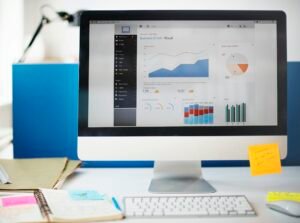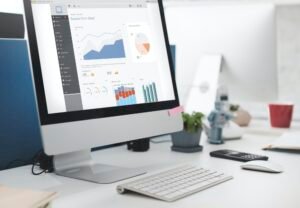Introduction
Looker BI Tool is a powerful business intelligence platform that allows businesses to analyze and visualize their data user-friendly and intuitively. In today’s data-driven world, businesses must make informed decisions based on accurate and timely data analysis. Looker BI Tool provides the tools and capabilities to do just that.
Data analysis plays a vital role in business decision-making. It helps businesses understand their customers, identify trends and patterns, and predict future outcomes. Businesses can gain valuable insights that drive growth, improve efficiency, and increase profitability by analyzing data.
Looker BI Tool enables businesses to harness the power of their data by providing a comprehensive suite of features and functionalities. From creating customizable dashboards to performing advanced analytics and predictive modeling, Looker BI Tool empowers businesses to make data-driven decisions confidently.
Understanding Looker BI Tool: Features and Benefits
Looker BI Tool offers a wide range of features, making it a versatile and powerful tool for data analysis. Some of the key features include:
1. Data Exploration: Looker BI Tool allows users to explore their data visually and interactively. Users can easily navigate their data, drill down into specific details, and uncover insights that may not be apparent at first glance.
2. Data Visualization: Looker BI Tool provides various visualization options, including charts, graphs, and maps, to help users understand their data at a glance. These visualizations can be customized to suit individual preferences and can be easily shared with others.
3. Advanced Analytics: Looker BI Tool offers advanced analytics capabilities, such as predictive modeling and machine learning algorithms, to help businesses uncover hidden patterns and accurately predict future outcomes.
4. Collaboration: Looker BI Tool allows users to collaborate with their teams by sharing dashboards, reports, and insights. Users can also leave comments and annotations on specific data points, facilitating collaboration and knowledge sharing.
5. Integration: Looker BI Tool seamlessly integrates with other applications and data sources, allowing businesses to consolidate their data and gain a holistic view of their operations. This integration capability enables businesses to make more informed decisions based on a comprehensive understanding of their data.
The benefits of using Looker BI Tool for data analysis are numerous. Firstly, Looker BI Tool provides businesses with a centralized platform to access and analyze their data, eliminating the need for multiple tools and systems. This streamlines the data analysis process and saves time and effort.
Secondly, Looker BI Tool offers a user-friendly interface that does not require extensive technical knowledge or coding skills. This makes it accessible to users of all levels, from business analysts to executives, enabling them to explore and analyze data independently.
Lastly, Looker BI Tool provides real-time data analysis capabilities, allowing businesses to make timely decisions based on the most up-to-date information. This is particularly important in today’s fast-paced business environment, where decisions must be made quickly to stay ahead of the competition.
Compared to other BI tools, Looker BI Tool stands out for its ease of use, flexibility, and scalability. Its intuitive interface and drag-and-drop functionality make it easy for users to create customized dashboards and reports without extensive training or technical expertise. Additionally, Looker BI Tool can handle large volumes of data and can be easily scaled to meet the needs of growing businesses.
Getting Started with Looker BI Tool: Installation and Setup
Before starting with Looker BI Tool, it is important to ensure your system meets the minimum requirements. Looker BI Tool is a web-based application that can be accessed through a web browser. It is compatible with most modern browsers, including Chrome, Firefox, Safari, and Edge.
To install the Looker BI Tool, you must download the installation package from the Looker website and follow the installation instructions provided. The installation process is straightforward and typically involves running the installer and following the prompts.
Once Looker BI Tool is installed, you must set up user accounts and permissions. This involves creating user profiles, assigning roles and permissions, and defining access levels to ensure that users only have access to the data and features that are relevant to their role.
Creating Customizable Dashboards with Looker BI Tool
One of the key features of Looker BI Tool is its ability to create customizable dashboards. Dashboards visually represent data and allow users to monitor key metrics and track performance in real-time.
To create a dashboard in Looker BI Tool, you must first connect to your data source and import the relevant data. Once the data is imported, you can start building your dashboard by selecting the desired visualizations and arranging them on the canvas.
Looker BI Tool offers various visualization options, including charts, graphs, tables, and maps. These visualizations can be customized to suit individual preferences by adjusting colors, fonts, labels, and other visual elements.
When creating a dashboard, it is important to consider the intended audience and the purpose of the dashboard. The dashboard should provide a clear and concise overview of the data, highlighting the most important insights and trends. It should also be easy to navigate and understand, with intuitive controls and interactive elements.
To create an effective dashboard, following best practices such as using consistent colors and fonts, logically organizing the layout, and providing clear labels and titles is recommended. It is also important to regularly update the dashboard with fresh data to ensure that it remains relevant and accurate.
Analyzing Data with Looker BI Tool: A Step-by-Step Guide
Analyzing data with Looker BI Tool involves a step-by-step process that starts with defining your analysis goals and ends with interpreting and presenting the results. Here is a step-by-step guide on how to analyze data using the Looker BI Tool:
1. Define your analysis goals: Before diving into the data, it is important to define your goals clearly. What questions are you trying to answer? What insights are you looking to uncover? By clearly understanding your goals, you can focus your analysis and ensure that you are asking the right questions.
2. Connect to your data source: Looker BI Tool allows you to connect to various data sources, including databases, spreadsheets, and cloud storage platforms. Once connected, you can import and analyze the relevant data into Looker BI Tool.
3. Explore and clean the data: Before analyzing the data, it is important to explore and clean it to ensure its quality and accuracy. Looker BI Tool provides tools and functionalities to help you explore the data, identify inconsistencies or errors, and clean them up.
4. Perform data analysis: You can perform your analysis once the data is cleaned and prepared. Looker BI Tool provides various tools and functionalities for data analysis, including filtering, sorting, aggregating, and calculating metrics.
5. Visualize the results: After performing the analysis, it is important to visualize the results clearly and concisely. Looker BI Tool offers a wide range of visualization options, including charts, graphs, and maps, that can help you present the insights in an easily understandable format.
6. Interpret and present the results: Finally, it is important to interpret the results of your analysis and present them meaningfully. Looker BI Tool allows you to annotate and comment on specific data points, facilitating collaboration and knowledge sharing.
Using Looker BI Tool for Predictive Analytics
Looker BI Tool offers advanced analytics capabilities that enable businesses to perform predictive analytics and make accurate predictions about future outcomes. Predictive analytics involves analyzing historical data to identify patterns and trends and using this information to predict future events.
To use Looker BI Tool for predictive analytics, you must first import your historical data into Looker BI Tool and clean it to ensure its quality and accuracy. Once the data is cleaned, you can analyze it using Looker BI Tool’s advanced analytics functionalities.
Looker BI Tool provides a variety of predictive modeling techniques, including regression analysis, time series analysis, and machine learning algorithms. These techniques can identify patterns and trends in the data and predict future outcomes.
Some examples of predictive analytics use cases include forecasting sales, predicting customer churn, optimizing inventory levels, and identifying fraud patterns. By using the Looker BI Tool for predictive analytics, businesses can gain valuable insights that can drive growth, improve efficiency, and increase profitability.
Collaborating with Teams using the Looker BI Tool
Looker BI Tool offers a range of collaboration features that enable teams to work together on data analysis projects. These features facilitate knowledge sharing, improve communication, and enhance collaboration among team members.
One of the key collaboration features of Looker BI Tool is the ability to share dashboards, reports, and insights with others. Users can easily share their work with colleagues by generating a shareable link or embedding the content in other applications or websites.
In addition to sharing content, Looker BI Tool allows users to leave comments and annotations on specific data points. This enables team members to provide feedback, ask questions, and share insights collaboratively.
Looker BI Tool also provides version control capabilities, allowing teams to track changes made to dashboards and reports over time. This ensures that everyone is working with the most up-to-date version of the content and reduces the risk of conflicting changes.
To collaborate effectively using the Looker BI Tool, it is important to establish clear roles and responsibilities within the team. This includes defining who has access to which data and features and establishing guidelines for sharing and commenting on content.
Integrating Looker BI Tool with Other Applications
Looker BI Tool offers various integration capabilities, allowing businesses to connect and consolidate their data from various sources. This integration capability enables businesses to gain a holistic view of their operations and make more informed decisions based on a comprehensive understanding of their data.
Looker BI Tool can be integrated with other applications and data sources through APIs (Application Programming Interfaces) and connectors. These APIs and connectors allow Looker BI Tool to communicate seamlessly with other applications and exchange data.
Some examples of integrations with other applications include CRM systems, marketing automation platforms, ERP systems, and cloud storage platforms. By integrating Looker BI Tool with these applications, businesses can consolidate their data and gain a unified view of their operations.
To integrate Looker BI Tool with other applications, you must configure the relevant APIs or connectors and establish the necessary connections. This may require some technical expertise or assistance from IT professionals.
Looker BI Tool Best Practices: Tips and Tricks
To use Looker BI Tool effectively, following best practices and optimizing its performance is important. Here are some tips and tricks for using the Looker BI Tool:
1. Define clear goals: Before starting any analysis or creating dashboards, it is important to define clear goals and objectives. This will help you focus your analysis and ask the right questions.
2. Keep it simple: When creating dashboards or reports, it is important to keep them simple and easy to understand. Avoid cluttering the dashboard with unnecessary visualizations or information.
3. Regularly update the data: To ensure that your analysis is accurate and up-to-date, it is important to update the data in the Looker BI Tool regularly. This can be done by scheduling data refreshes or setting up automated data pipelines.
4. Use filters and parameters: Looker BI Tool provides powerful filtering and parameterization capabilities that allow you to slice and dice your data in various ways. Take advantage of these features to explore different scenarios and analyze the data from different angles.
5. Optimize performance: To optimize Looker BI Tool’s performance, it is important to follow best practices such as using appropriate data modeling techniques, optimizing queries, and leveraging caching and indexing capabilities.
6. Train and educate users: Looker BI Tool is a powerful tool that requires some training and education to use effectively. Provide training and resources to your users to ensure they can maximize Looker BI Tool’s capabilities.
Conclusion: Unlocking the Power of Data with Looker BI Tool
In conclusion, Looker BI Tool is a powerful business intelligence platform that enables businesses to analyze and visualize their data user-friendly and intuitively. Using the Looker BI Tool, businesses can confidently make data-driven decisions, driving growth, improving efficiency, and increasing profitability.
Looker BI Tool offers many features and benefits, including data exploration, visualization, advanced analytics, collaboration, and integration capabilities. It stands out from other BI tools in the market for its ease of use, flexibility, and scalability.
To start with Looker BI Tool, businesses must ensure that their system meets the minimum requirements and follow the installation and setup process. Once set up, businesses can create customizable dashboards, perform data analysis, use predictive analytics capabilities, collaborate with teams, integrate with other applications, and follow best practices for optimal performance.
By unlocking the power of data with Looker BI Tool, businesses can gain valuable insights that can drive growth, improve efficiency, and increase profitability. In today’s data-driven world, Looker BI Tool is valuable for businesses of all sizes and industries.
If you’re looking for a comprehensive guide on CMO dashboards, Studio Insighters has got you covered. Their article, “CMO Dashboards: A Comprehensive Guide,” provides valuable insights and tips on creating effective dashboards for Chief Marketing Officers. Whether you’re a seasoned marketer or just starting, this article will help you understand the importance of data visualization and how to leverage the Looker BI tool to drive marketing success. Check it out here.







